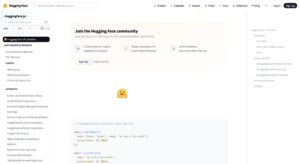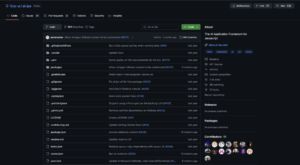10 Best JavaScript Frameworks for Building AI Systems (October 2024)
As artificial intelligence continues to reshape the tech landscape, JavaScript acts as a powerful platform for AI development, offering developers the unique ability to build and deploy AI systems directly in web browsers and Node.js environments. The ecosystem has rapidly evolved to support everything from large language models (LLMs) to neural networks, making it easier […] The post 10 Best JavaScript Frameworks for Building AI Systems (October 2024) appeared first on Unite.AI.


As artificial intelligence continues to reshape the tech landscape, JavaScript acts as a powerful platform for AI development, offering developers the unique ability to build and deploy AI systems directly in web browsers and Node.js environments. The ecosystem has rapidly evolved to support everything from large language models (LLMs) to neural networks, making it easier than ever for developers to integrate AI capabilities into their applications.
In this guide, we'll explore the top JavaScript frameworks that are driving the future of AI development, with a focus on practical applications and real-world implementations.
1. LangChain.js
LangChain.js has revolutionized the way developers interact with LLMs in JavaScript environments. As the JavaScript implementation of the popular LangChain framework, it provides a robust foundation for building sophisticated AI applications that leverage the power of LLMs. The framework excels in managing complex chains of operations, allowing developers to create advanced AI workflows that combine multiple models and tools.
The framework's strength lies in its extensibility and integration capabilities. Developers can easily connect their applications with various LLM providers, databases, and external services while maintaining a clean and consistent API. LangChain.js also provides sophisticated memory systems for maintaining context in conversations and advanced prompt management tools that help developers optimize their interactions with language models. The framework's modular design allows for easy customization and extension, making it suitable for both simple chatbots and complex AI applications.
Key Features:
- Comprehensive prompt management system with templating and version control
- Advanced memory systems for maintaining conversation context
- Modular chain architecture for complex AI workflows
- Extensive integration options with major LLM providers and external services
- Built-in tools for prompt optimization and testing
2. TensorFlow.js
TensorFlow.js stands as Google's flagship JavaScript framework for machine learning and AI development, bringing the power of TensorFlow to web browsers and Node.js environments. The framework enables developers to build, train, and deploy machine learning models entirely in JavaScript, supporting everything from basic neural networks to complex deep learning architectures. Its versatility makes it particularly valuable for teams looking to implement AI capabilities without leaving the JavaScript ecosystem.
What distinguishes TensorFlow.js is its comprehensive ecosystem and optimization capabilities. The framework leverages WebGL acceleration for high-performance computing in browsers and provides sophisticated tools for model conversion and optimization. This allows developers to run pre-trained models from Python TensorFlow directly in JavaScript applications, making it an excellent bridge between traditional ML development and web-based deployment. The framework also supports transfer learning, enabling developers to fine-tune existing models for specific use cases while minimizing computational requirements.
Key Features:
- Hardware-accelerated ML operations using WebGL and Node.js bindings
- Comprehensive model conversion pipeline from Python TensorFlow
- Built-in support for transfer learning and model fine-tuning
- Advanced visualization tools for model training and debugging
- Extensive collection of pre-trained models and layers
3. Transformers.js

Transformers.js, developed by Hugging Face, brings the power of transformer-based models directly to JavaScript environments. This framework enables developers to run sophisticated AI models directly in web browsers and Node.js applications, opening up new possibilities for client-side AI processing. The framework's optimized implementation ensures efficient execution of transformer models while maintaining compatibility with the broader Hugging Face ecosystem.
One of the framework's most significant advantages is its ability to run models entirely in the browser, reducing server costs and enabling offline functionality. Transformers.js handles complex tasks such as tokenization, model optimization, and inference with remarkable efficiency. The framework also includes sophisticated caching mechanisms and model compression techniques to optimize performance in resource-constrained environments. Its seamless integration with the Hugging Face Hub gives developers access to thousands of pre-trained models, making it easier than ever to implement state-of-the-art AI capabilities in web applications.
Key Features:
- Direct browser-based execution of transformer models with WebGL acceleration
- Seamless integration with Hugging Face's extensive model hub
- Advanced tokenization and preprocessing pipeline
- Optimized model compression and caching systems
- Comprehensive support for various transformer architectures and tasks
4. KaibanJS
KaibanJS represents the cutting edge of AI development in JavaScript, specifically designed for building and managing multi-agent AI systems. The framework's architecture is built around the concept of autonomous AI agents that can communicate and collaborate, making it ideal for complex applications requiring coordinated AI behavior. Its native JavaScript implementation ensures optimal performance and seamless integration with existing web technologies.
What sets KaibanJS apart is its sophisticated approach to agent orchestration. The framework provides built-in tools for managing agent lifecycles, handling inter-agent communication, and coordinating complex workflows between different AI components. This makes it particularly valuable for enterprise applications where multiple AI systems need to work together cohesively. The framework also includes advanced debugging capabilities and monitoring tools, enabling developers to track and optimize their multi-agent systems effectively.
Key Features:
- Advanced multi-agent orchestration system with built-in communication protocols
- Real-time monitoring and visualization of agent interactions
- Scalable architecture supporting hundreds of concurrent AI agents
- Comprehensive workflow management tools with error handling
- Built-in testing and debugging tools for agent behavior verification
5. Brain.js

Brain.js has emerged as one of the most popular neural network libraries in the JavaScript ecosystem, offering an elegant balance between simplicity and power. The framework excels in making neural network implementation accessible to JavaScript developers while providing the flexibility needed for complex applications. Its straightforward API masks the complexity of neural network operations, allowing developers to focus on solving problems rather than managing low-level neural network details.
What distinguishes Brain.js is its intuitive approach to neural network training and implementation. The framework supports various network architectures, including feed-forward networks, recursive neural networks, and long short-term memory (LSTM) networks. Its GPU acceleration capabilities, powered by WebGL, enable high-performance training and execution in browser environments. Brain.js also includes sophisticated features for network configuration and training, such as cross-validation, early stopping, and learning rate optimization, making it suitable for both educational purposes and production applications.
Key Features:
- Streamlined API for neural network creation and training
- GPU acceleration support for improved performance
- Built-in support for various neural network architectures (feed-forward, RNN, LSTM)
- Advanced training options including cross-validation and early stopping
- Comprehensive data normalization and preprocessing utilities
6. MediaPipe.js
MediaPipe.js, developed by Google, represents a breakthrough in bringing real-time machine learning capabilities to web applications. The framework specializes in media processing tasks like computer vision and audio analysis, offering high-performance solutions that run directly in web browsers. Its optimization for real-time processing makes it particularly valuable for applications requiring live AI analysis of video, audio, or sensor data.
What sets MediaPipe.js apart is its comprehensive suite of pre-built solutions and its efficient pipeline architecture. The framework includes production-ready implementations for tasks like face detection, hand tracking, pose estimation, and object detection, all optimized for real-time performance. Its modular design allows developers to combine multiple ML solutions into efficient processing pipelines, while WebGL acceleration ensures smooth performance even on mobile devices. The framework's cross-platform support and extensive documentation make it an excellent choice for developers building sophisticated real-time AI applications.
Key Features:
- Real-time ML processing optimized for web environments
- Pre-built solutions for common computer vision tasks
- Advanced pipeline architecture for complex ML workflows
- Hardware-accelerated processing using WebGL
- Cross-platform support including mobile browsers
7. Natural

Natural has established itself as a comprehensive NLP library for JavaScript, providing essential tools for text-based AI applications. The framework offers a pure JavaScript implementation of common NLP algorithms, making it ideal for projects that require text processing capabilities without the overhead of larger machine learning frameworks. Its modular design allows developers to use only the components they need, optimizing performance and resource usage.
Beyond its core NLP capabilities, Natural provides sophisticated features for language detection, sentiment analysis, and text classification. The framework's tokenization and stemming algorithms support multiple languages, making it valuable for international applications. Natural's straightforward API and extensive documentation make it particularly accessible for developers new to NLP, while its advanced features satisfy the needs of more complex applications requiring detailed text analysis and processing.
Key Features:
- Comprehensive tokenization and stemming support for multiple languages
- Built-in algorithms for text classification and sentiment analysis
- Efficient string distance calculations and phonetics algorithms
- Extensible architecture for custom NLP implementations
- Lightweight and modular design for optimal performance
8. Hugging Face JavaScript SDK

The Hugging Face JavaScript SDK serves as a powerful bridge between web applications and the vast ecosystem of AI models available on the Hugging Face Hub. This SDK enables developers to seamlessly integrate state-of-the-art machine learning models into their JavaScript applications, providing access to thousands of pre-trained models for various AI tasks. The framework's design focuses on simplifying the process of model deployment while maintaining high performance.
What sets the Hugging Face JavaScript SDK apart is its comprehensive approach to model management and deployment. The SDK handles complex tasks such as model loading, tokenization, and inference optimization automatically, allowing developers to focus on building their applications. Its caching mechanisms and efficient data handling make it particularly suitable for production environments where performance and reliability are crucial. The framework also provides detailed metrics and monitoring capabilities, enabling developers to track model performance and usage patterns.
Key Features:
- Direct access to thousands of pre-trained models from Hugging Face Hub
- Optimized model loading and caching mechanisms
- Advanced tokenization and preprocessing pipelines
- Comprehensive error handling and debugging tools
- Real-time monitoring and performance metrics
Visit Hugging Face JavaScript SDK →
9. ML5.js

ML5.js emerges as a user-friendly machine learning framework specifically designed for creative coding and web-based AI applications. Built on top of TensorFlow.js, this framework makes machine learning accessible to artists, creative coders, and developers who want to incorporate AI capabilities into their web projects. Its approachable API and focus on common creative computing tasks make it an excellent choice for interactive AI applications, educational projects, and artistic endeavors.
The framework's strength lies in its simplicity and pre-trained models optimized for creative applications. ML5.js includes ready-to-use models for tasks like image classification, pose estimation, sound recognition, and natural language processing, all accessible through an intuitive API. The framework's integration with the p5.js creative coding library makes it particularly valuable for interactive installations and creative technology projects. Its comprehensive documentation and examples, coupled with active community support, make it an ideal starting point for developers new to machine learning while providing the flexibility needed for more complex applications.
Key Features:
- Pre-trained models optimized for creative applications and interaction
- Seamless integration with p5.js and other creative coding libraries
- Simplified API for common machine learning tasks
- Real-time processing capabilities for interactive applications
- Extensive educational resources and community support
10. AI.JSX

AI.JSX emerges as an innovative framework that brings the familiar paradigms of React development to AI application building. Developed by Fixie.ai, this framework enables developers to create sophisticated AI applications using JSX syntax and component-based architecture. By leveraging the declarative nature of React, AI.JSX makes it intuitive to build complex AI-powered features while maintaining clean, maintainable code structures.
What sets AI.JSX apart is its sophisticated approach to handling AI interactions within the component lifecycle. The framework provides built-in streaming capabilities for real-time AI responses, elegant handling of conversation state, and seamless integration with various AI models. Its TypeScript-first approach ensures type safety while building AI applications, while its React-based architecture makes it particularly valuable for teams already familiar with React development. The framework's design patterns for managing AI state and side effects make it easier to build robust, production-ready AI applications.
Key Features:
- Component-based architecture for building AI applications
- Built-in streaming support for real-time AI interactions
- Sophisticated conversation state management
- Native TypeScript support with full type safety
- Seamless integration with modern React applications
The Bottom Line
The JavaScript AI framework ecosystem has matured significantly, offering developers a rich selection of tools for building sophisticated AI applications. From powerful machine learning frameworks like TensorFlow.js to specialized solutions like KaibanJS and Natural, developers can choose frameworks that best match their specific needs, whether they're building complex multi-agent systems, implementing natural language processing, or developing neural networks. As AI continues to evolve, these frameworks provide the foundation for creating innovative applications that leverage the latest advances in AI technology.
The post 10 Best JavaScript Frameworks for Building AI Systems (October 2024) appeared first on Unite.AI.

















